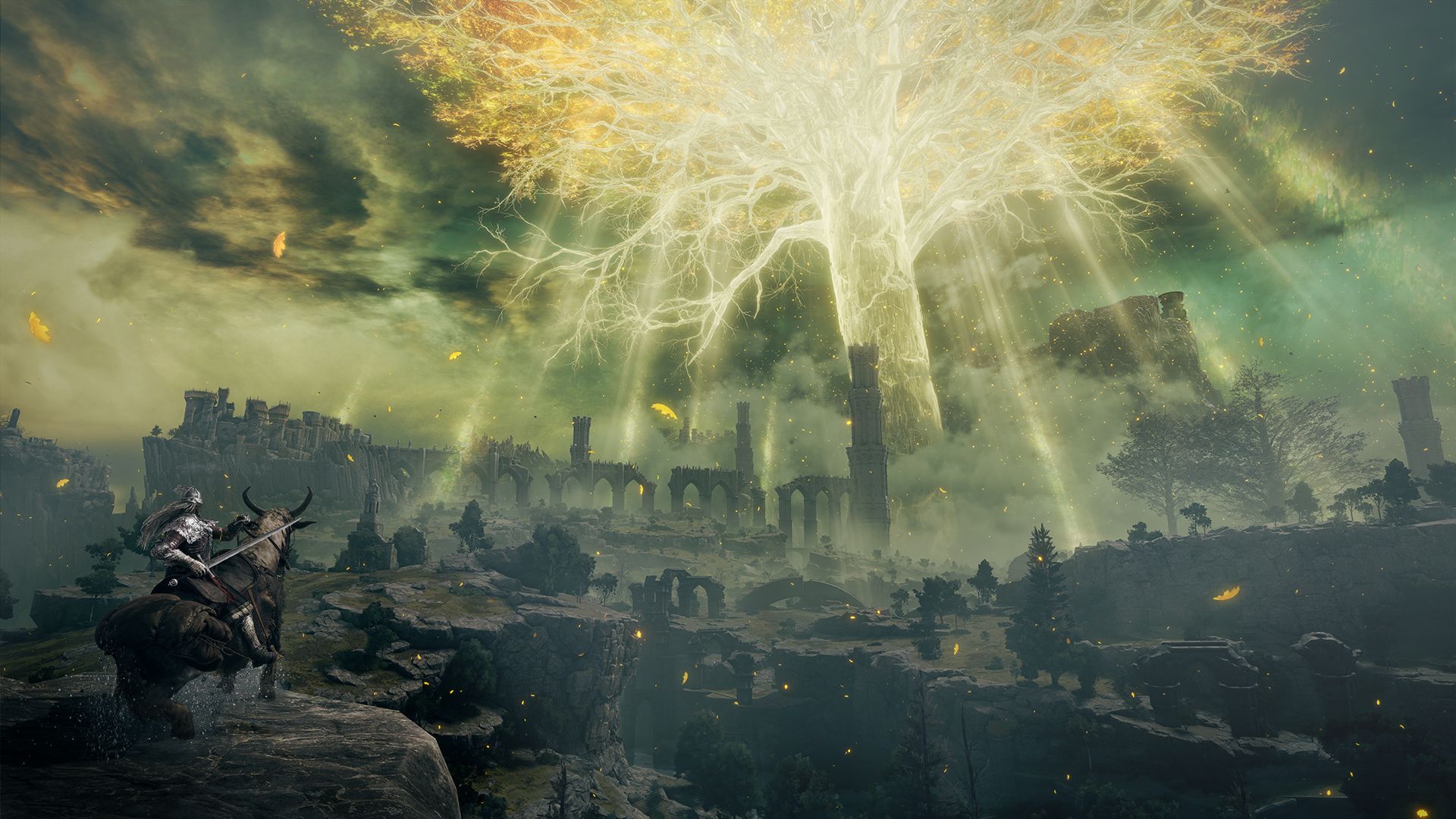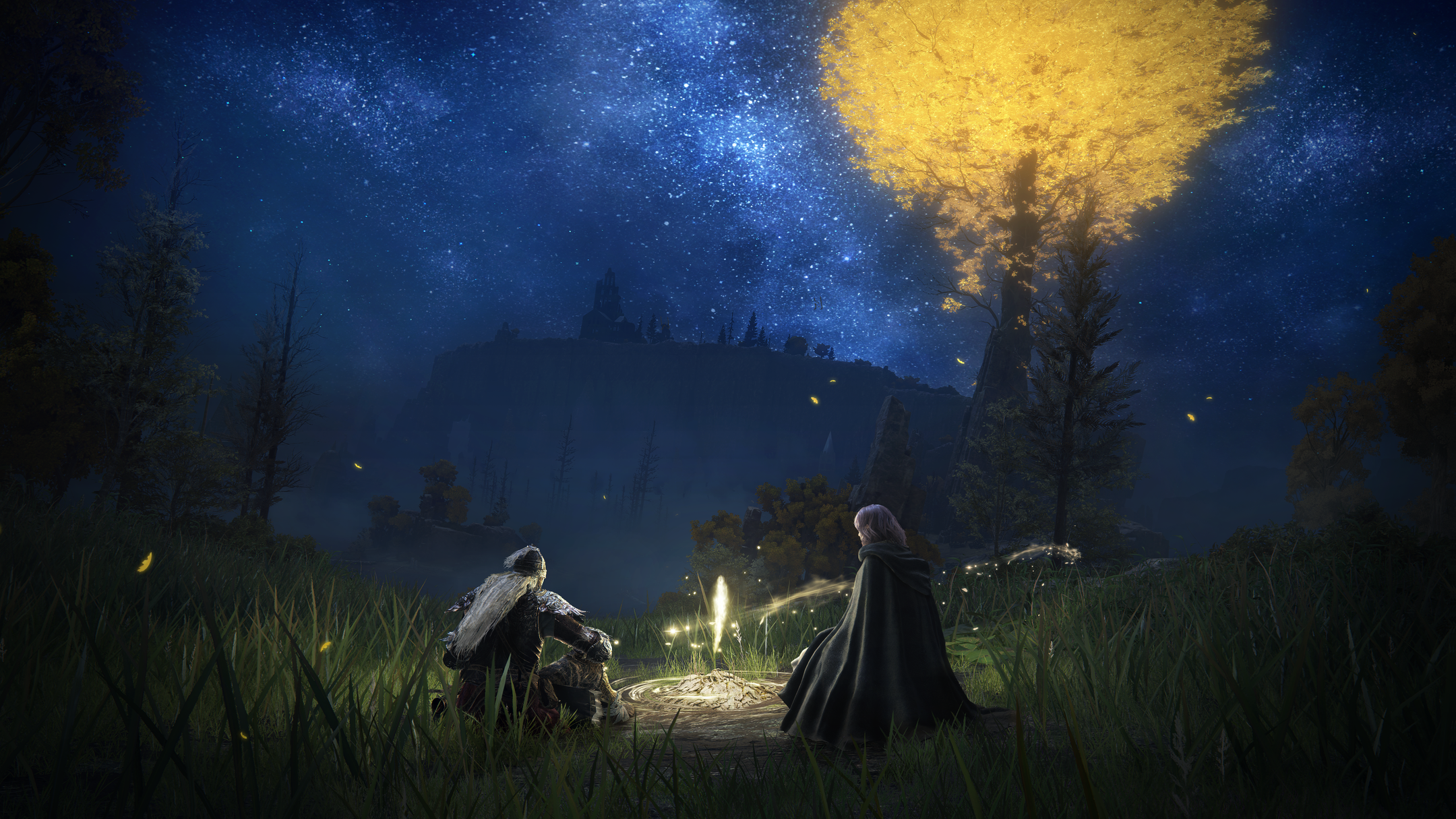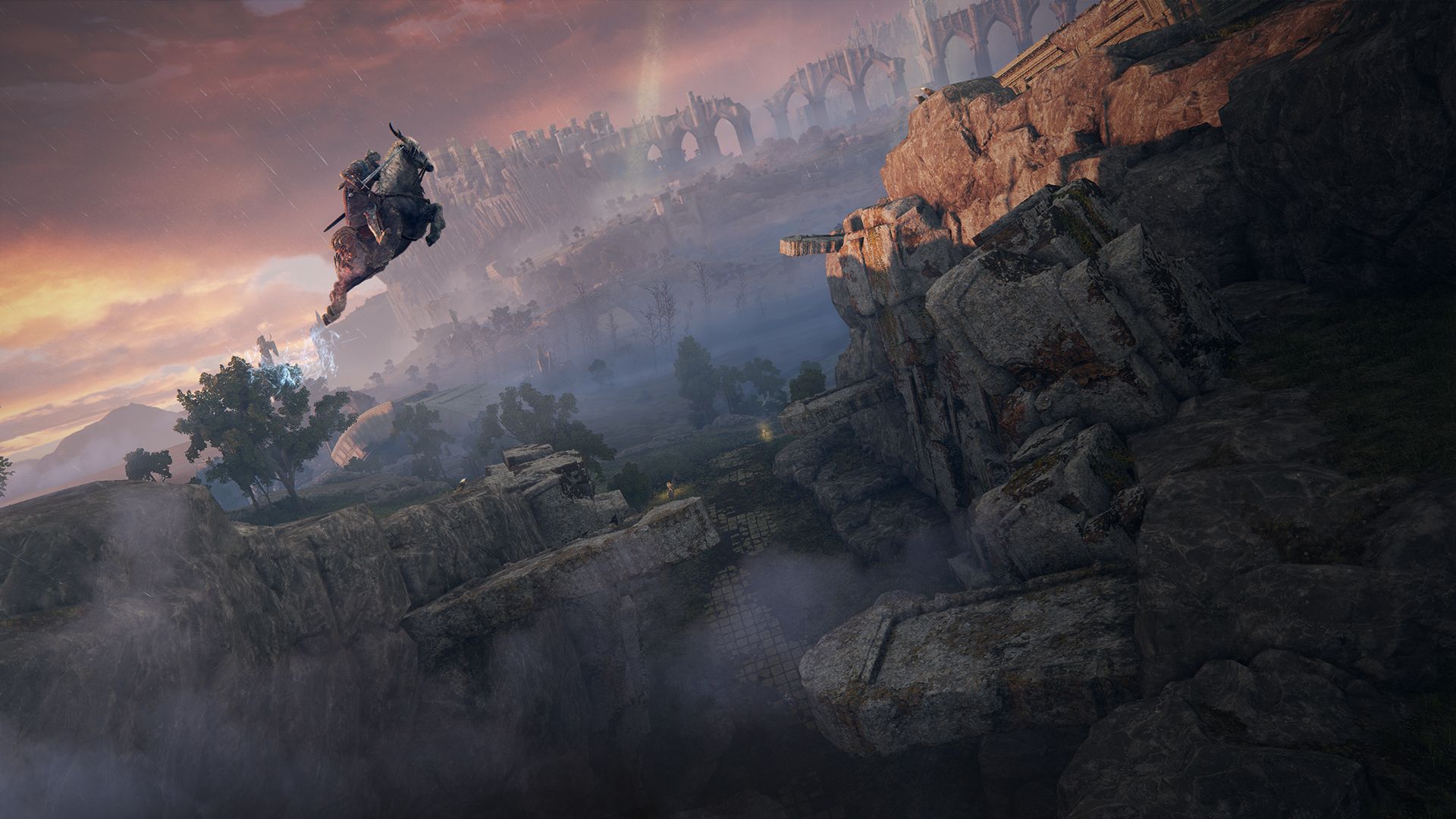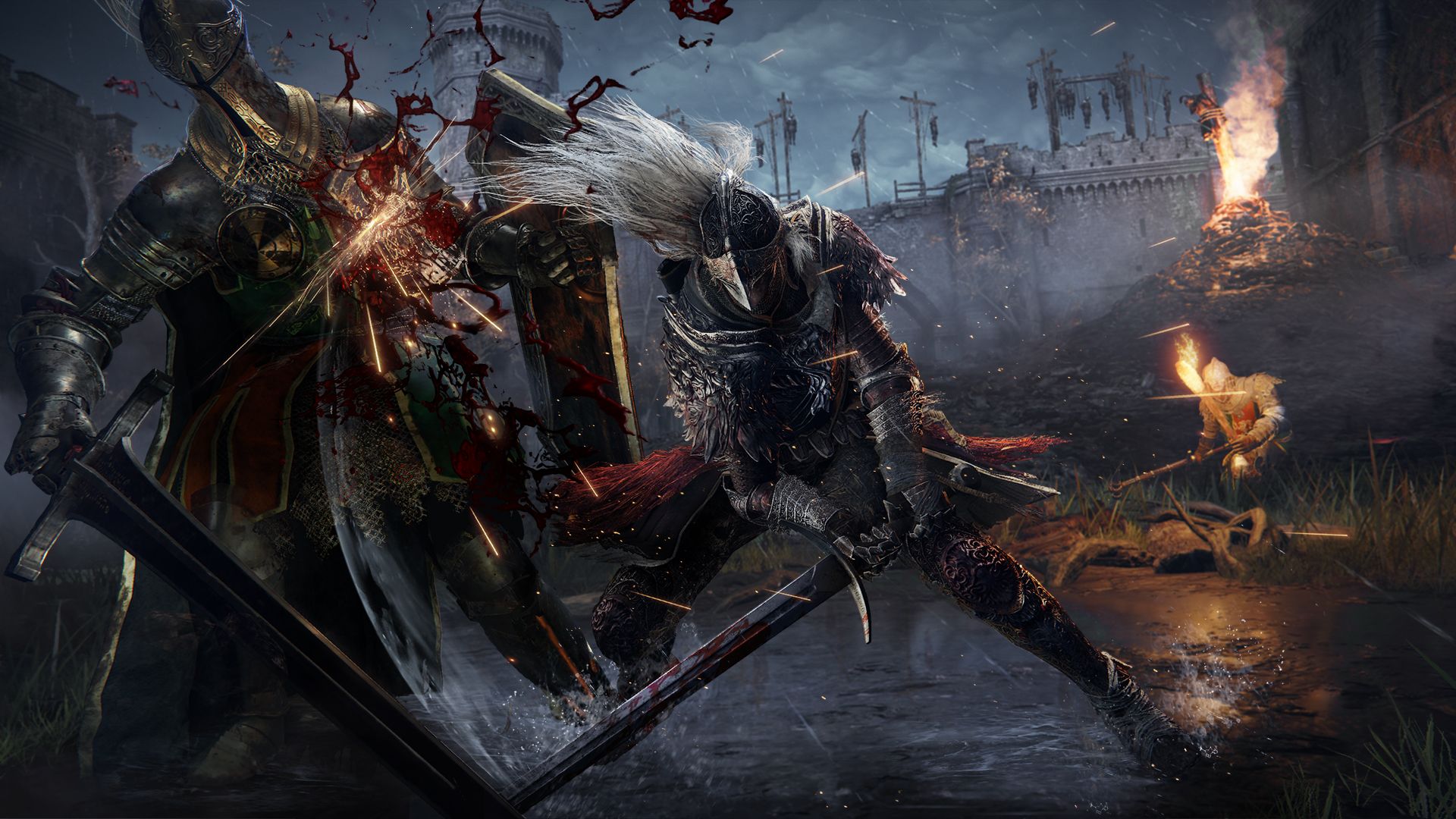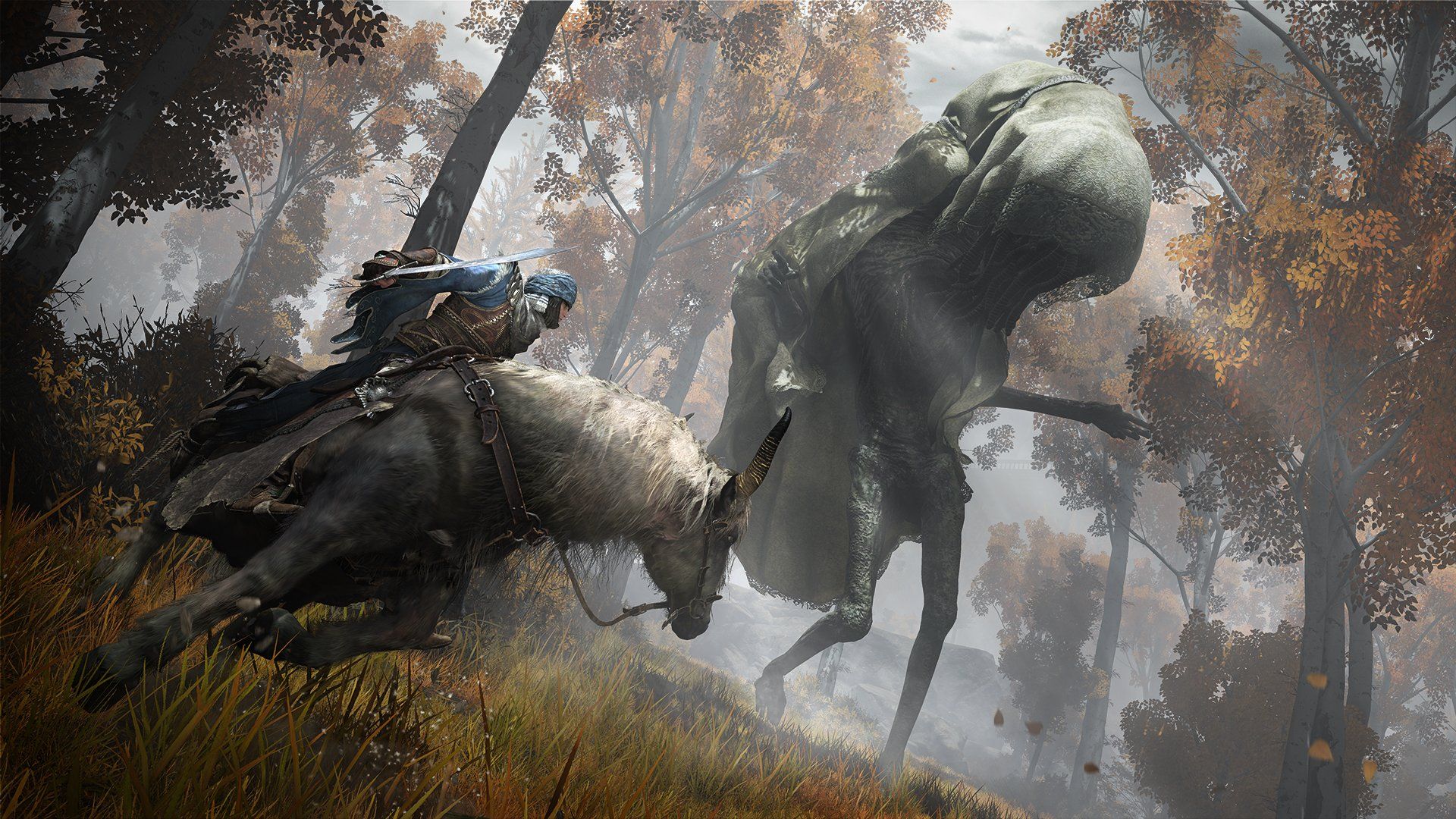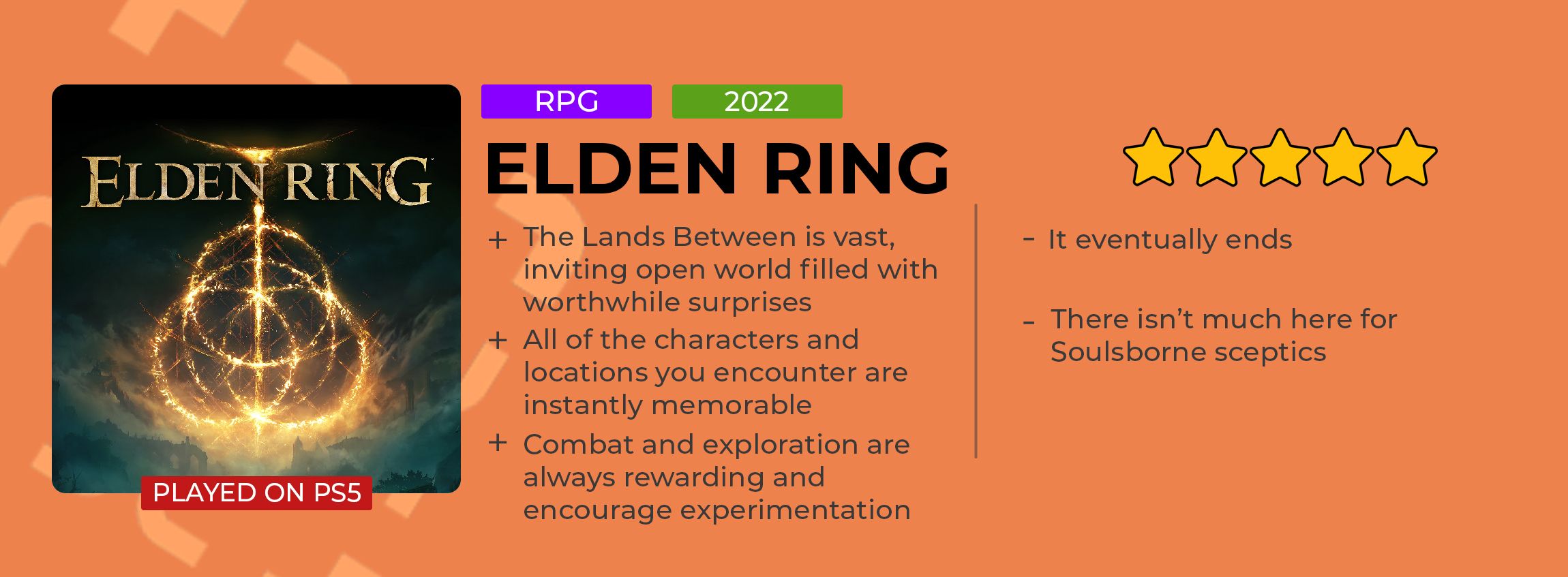Elden Ring is a triumphant exercise in fantastical misery. The Lands Between is a landscape defined by its own hopelessness, a splintered kingdom that has long fallen victim to death and decay, with only a few unfortunate souls still clinging onto life.
All in this realm feels lost, so when we step out of the darkness to restore order, the task before us appears insurmountable. We are a small, frail soul in a world dominated by tyrannical rulers and grotesque creatures beyond compare. Each step forward could be our last, a testament to our own futility as we bat away oncoming soldiers while scaling battlements or flee from spiders crawling amidst underground caverns. The vibe is very bad indeed, but even the bleakest of ultimatums can’t stifle the curiosity this game instils within you. It’s unlike anything else out there, an invitation to lose yourself and never look back.
FromSoftware has crafted an open world adventure that somehow surpasses all conceivable expectations. It combines Dark Souls’ natural sense of discovery with the foreboding atmosphere of Bloodborne, while perfecting this combination with a combat system that feels equal parts Sekiro and Demon’s Souls. Elden Ring is an unflinching masterpiece, and a marquee example of what this medium can achieve when it is willing to accept our investment without compromise. Now, step forward and embrace your destiny as a lowly Tarnished.
Elden Ring will be both keenly familiar to Soulsborne veterans while simultaneously providing an experience that feels completely alien. The fundamentals of combat, exploration, and cryptic storytelling remain untouched, but the addition of an open world recontexualises how all of these elements operate. From the moment you emerge in the sombre fields of Limgrave you are given absolute freedom to make this realm your own. A hooded NPC spouts out a deluge of dialogue that provides a small idea of your overall goal, but you can just as easily murder this idiot and charter your own destiny.
Small wisps of golden particles emanating from sights of Lost Grace (read: bonfires) lead to the ‘main quest’ but can be ignored if you so choose. Your primary task is to eliminate the Five Lords across The Lands Between and use them to reclaim the Elden Ring. What this will achieve and whether it is even a good thing remains unclear, a goal shrouded in equal parts mystery and trepidation as you step forward and strip this place of what little civilization it has left. It’s never made clear if you’re a noble saviour or a worthless poltroon robbing this apocalypse of resources before leaving it to crumble. I love the ambiguous nature of Elden Ring, a quality that isn’t sacrificed despite how vast the world you inhabit manages to be. Your hand is seldom held, even if item descriptions and tutorials are far more generous when compared to previous Soulsborne titles. The menu is filled with tools and tips to make your journey a little easier, but they’re nothing more than a foundation. You’re still taking this challenge on through your own devices, and it’s masterful.
Given I was up against the clock to hit the review deadline, perhaps I should have just followed the golden trails to my desired location, but I needed to embrace my rampant curiosity. Much of my adventure was spent riding on horseback in random directions, often derailing my trajectory to investigate ominous catacombs or to scale up mountains in the hopes of uncovering rare treasure. Not a single moment felt wasted, because I was always building the legacy of my character and crafting them into someone who would soon be capable of besting the Lords who eluded me. When I finally stumbled upon major landmarks and stepped into sprawling dungeons I felt prepared, yet still feared what horrors might await me in the castles, swamps, villages, and ethereal wastelands. I’d meet death time and time again, but this only spurred me on.
While Dark Souls and other games of its ilk encourage exploration, they operate on level design conventions that emphasise claustrophobia. You often feel trapped, like you have no choice but to press onward in the faint hope that a bonfire awaits where you can rest and ruminate on the awaiting gauntlet. FromSoftware thrives on moments like this, but Elden Ring chooses to throw them all away and never suffers for it. If a particular region or boss battle proves too challenging you can simply fast travel away and seek victory elsewhere. The world is vast enough that across my continued playthrough there was always something to uncover, and always fiends waiting to face me on the battlefield. Not since Breath of the Wild has a world of this magnitude managed to feel so effortless, curated to such an extreme that every minute detail clearly exists with a distinct purpose.
The quality of locations is staggering too. Elden Ring’s marketing rarely ventured outside Limgrave, a region defined by its miserable greenery and a handful of enemies that feel pulled straight from a high fantasy novel. This is but a sliver of what The Lands Between has to offer across its multiple regions, with each one capable of sporting a Soulsborne title of its own with enough expansion. Liurnia is a dreamlike collage of crystalised swamplands and elegant castles once ruled by an all-powerful sorceress, now doomed to ruin as its once mighty ruler slips into an eternal slumber. Caelid is a hostile desert wasteland defined by crimson skies and scorched battlefields, clinging onto life as its once unstoppable champion roams the desert gorging on the corpses of his lowly soldiers. The Great Plateau is home to yet another rival monarchy, the remnants of a great battle spread across its many fields as a towering castle awaits in the distance.
While the surface already appears vast in its sheer possibilities, beneath it awaits the remnants of forgotten civilizations, made clear by crumbling architecture and subtle clues etched throughout the environment. Known as the Siofra River, this gorgeous underground cavern is in possession of a starry sky spread across its endless ceiling, small specks of light raining down onto the awaiting monsters below as you can’t help but stop and stare at its magnificence. Elden Ring is massive, yet this uncompromising scale also hides an unexpectant density that encourages you to uncover each and every little secret hidden amidst its tired plains. I welcomed every new occurrence, letting it wash over me with an almost comforting warmth of melancholy.
Each new location is a marvel, but it’s the people situated within them who shine even brighter. You will stumble upon merchants, warriors, and maidens all with their own bespoke stories to tell, many of which will intertwine into one another in ways that are impossible to predict. One example sticks out to me - I found a blind girl sitting atop a cobblestone wall as I approached a besieged castle. She begged me to deliver a letter to her ignorant father who had stayed behind to fight. I did so, but upon returning to deliver the news I found her bloody corpse, alongside a sword that once belonged to her treacherous parent. This felt like my mistake, and if I had seen the signs I could have saved a young girl from her own death and unlocked an entirely new questline that now goes untouched.
Elden Ring is filled with moments like this, an abundance of stories you might never see through to the end, left to piece together conclusions from disparate conversations as the opportunity to resolve them passes you by. Opaque spirits can be found throughout The Lands Between, uttering small pieces of dialogue that offer a glimpse into the realm’s history while begging for a chance at eventual salvation. You can’t help them, having no choice but to take their words into account and ensure you don’t repeat the same mistakes. It’s poignant in its depiction of anguish, unafraid to make you feel guilt in the face of adversity.
Where characters come to life is The Roundtable Hold, a hub area much like Majula or The Nexus - a place where wayward souls have decided to gather far away from the harsh outside world. We don’t know where this corrupt haven is located, only that our weapons are useless here as we’re asked to listen and learn about the unfortunate people who also happen to call this place home. It begins rather empty, with only a scant few knights and merchants loitering across its many rooms. But as you meet fellow strangers in the world they will come knocking, offering wares to sell and stories to tell that each contribute to their own overarching narratives. The Hold grows alongside you, new rooms opening up as our journey progresses with some characters leaving while others decide to stay. It can splinter off into so many potential directions that I’m already planning my second playthrough, now fully aware how to combat the evil intentions of certain characters.
Talking about how Elden Ring plays almost feels superfluous. It remains a Soulsborne experience, one that demands precise reflexes and ample amounts of patience in order to survive and emerge victorious from its many, many boss battles. You will meet defeat on a constant basis, having to accept mistakes and keep moving forward while curating a build that perfectly reflects your individual playstyle. A starting class will outfit you with certain attributes and equipment in the opening hours, but this is merely a template. I began as a timid astrologer, but over the course of 30+ hours I grew into a valiant knight who could swing greatswords with the best of them, while still being able to hurl spells from a safe distance when I fancied being a strategic little weasel instead of getting in close. It’s open world Dark Souls, just like we knew it would be. The only question mark was ‘will it be any good?’, and the answer is a louder, more resounding ‘yes’ than I ever could have imagined.
Combat feels built for repeat playthroughs and experimentation, while the freeform nature of exploration ensures that nobody will experience Elden Ring in quite the same way. We will all fight the same bosses and progress through the same dungeons, but the order in which these are approached and how we decide to duke it out with enemies will be entirely unique. In a genre that has become infamous for its derivative design this feels like an innovative step in the right direction, a reclamation of player agency where every little thing we do matters in some tangible way. This is the most engrossing game world I’ve had the privilege to explore in the past several years, with each new discovery posing questions that can only be answered by prying even further, pushing myself into environments and situations that would once make me uncomfortable. Yet now I was powerful enough to face such demons, to reclaim the Elden Ring and rise from the ruined reputation of a Tarnished with no equal.
Elden Ring is a masterpiece. It can be easy to slip into hyperbole when critiquing a game of this prestige, one that has been marred by anticipation for so long that we all expected it to be good, or to usher in a new era of gaming majesty like we’ve never seen before. Despite all of these expectations, it manages to accomplish a feat none thought possible.
FromSoftware doesn’t rewrite the medium’s rulebook, but does tear its own tenets asunder while reconstructing them into a cohesive whole that outclasses all that came before it. The Lands Between invites you to explore it with an unparalleled level of freedom, offering up a plate of seemingly impenetrable challenges and intimately constructed stories that are always a delight to indulge in. This is, without doubt, one of the best games in recent memory.
A review code was provided for the purposes of this review.

.jpg)
